|
Having trouble viewing this email? View it as a Web page.

|
|
|
Editor: Kelly Sprute Aug. 4, 2021
Making a Difference

Researchers reported that the nitrogen input from legume cover crops and manure prior to corn planting made the corn phase of rotations the main source of nitrous oxide emissions. Corn field image courtesy of Adobe Stock.
Nitrous Oxide Emissions Coming from Legume Cover Crops, Manure, Can Be Reduced
The application of manure after the growth and demise of legume cover crops in rotations is a recipe to increase nitrous oxide releases during ensuing corn growth, according to Penn State University researchers.
Nitrous oxide is important because it is about 300 times better at trapping heat than is carbon dioxide. With organic agriculture growing in significance, nitrous oxide emissions are undergoing added scrutiny because soil fertility in organic agriculture relies on microbial cycling of nutrient inputs from legume cover crops and animal manure.
Researchers proposed several strategies to reduce those emissions, such as removing a fraction of the legume aboveground biomass before corn planting. Funding was provided by USDA’s National Institute of Food and Agriculture. For more information, read this Penn State News article.
|
|

Agriculture Secretary Tom Vilsack on the Intent to Nominate Chavonda Jacobs-Young, Ph.D. to Serve as Under Secretary for Research, Education, and Economics
Dr. Jacobs-Young has a deep understanding of USDA’s commitment to science, research, and education and of the importance of advancing scientific knowledge to best serve the American people. For many years, she has served as an influential leader in agricultural science and research with notable experience working across the Department and across federal government. Since 2014, Dr. Jacobs-Young has served as Administrator of the Agricultural Research Service, USDA’s chief scientific in-house research agency. For more information, read the USDA statement.
|
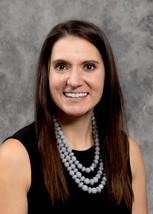
Introducing NIFA’s Newest Deputy Director for the Institute of Food Safety and Nutrition
Dr. Suzanne Stluka joined NIFA in July 2020 where she served as the Division Director for Family and Consumer Sciences and Youth and 4-H in the Institute of Youth, Family, and Community. Prior to joining NIFA, she served as the Associate Director at Montana State University Extension for one year. She served in several leadership roles at South Dakota State University Extension for 13 years, leading the Expanded Food and Nutrition Education Program the entire time and adding SNAP-Ed a few years later. Suzanne started her career as an Outreach Registered Dietitian for a Veterans Affairs facility in Illinois. Throughout her career she maintained an active research and extension portfolio, exploring topics such as food insecurity, nutrition education, farm to school, community coaching, and policy, systems, and environmental work in the areas of nutrition and physical activity. She earned a B.S. degree in Family and Consumer Sciences Education and Nutrition (Dietetics) from South Dakota State University, an M.S. degree in Family and Consumer Sciences from the University of Eastern Illinois, and her Ph.D. degree in Human Sciences from the University of Nebraska-Lincoln. She is also a Registered Dietitian Nutritionist.
|

Meet NIFA’s Newest National Science Liaison
R. Brent Elrod will serve as NIFA’s National Science Liaison, focusing on 4-H and Community Development, including economic recovery. Brent has been with the agency since 2008, starting as a program specialist, and the past seven years as a national program leader. He’s also the acting division director for 4-H while a national search is underway. His work supports a portfolio of research, education, and extension programs that emphasize improving the nation’s health, nutrition, and youth, family, and community quality of life. In 2021, he helped launch the EXCITE initiative, an interagency agreement with the Centers for Disease Control and Prevention, to engage Cooperative Extension nationwide in the promotion of COVID 19 vaccine awareness and uptake.
As National Science Liaison, Brent will collaborate with the Land-grant University System, ECOP/Cooperative Extension, 4-H Council, federal agencies, and non-governmental organizations to build and strengthen partnerships that promote economic recovery from the pandemic with an emphasis on positive youth development to ensure an educated and skilled leadership pool and workforce.
|

NIFA Welcomes New Food Safety Division Director
Dr. Shoushan (Steve) Zeng is NIFA’s new Food Safety Division Director. Growing up in rural Jiangxi of China, he has always had a passion for science and production of animals and foods. Upon completion of his B.S. degree in animal science at Jiangxi Agricultural University, he studied meat and dairy sciences at Mississippi State University for his M.S. degree. Steve earned his Ph.D. degree in Food Technology at Clemson University. He then served as an Extension Food Technologist, Professor, Department Head at Langston University and Food Scientist/R&D Manager in the cheese industry. He hopes to bring his experiences in extension, research, academia, and administration to serve our 1862-, 1890-, 1994-land grant partners, stakeholders and under-served communities on a national platform provided by USDA-NIFA.
|
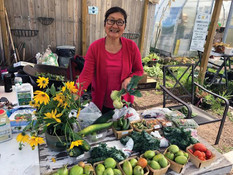
Risk Management Education for Underserved Producers
USDA is committed to improving equity and access to its programs, including Federal crop insurance. This year, USDA’s Risk Management Agency (RMA), which oversees the national Federal crop insurance program, will invest nearly $1 million in risk management education projects with trusted partners. Many of the projects help ensure that farmers know how to plan for adverse weather, natural disasters, or a volatile marketplace. RMA hopes these educational opportunities build invaluable skill sets in communities that have historically lacked access to training and resources. For more information, read the USDA blog.
USDA’s risk management education for underserved producers, image courtesy of the USDA.
|

Explaining Agriculture to Everyone
Farmers and the ag industry are becoming more involved in sharing what they do, and how they do it, with everyone, whether it's talking in person, using social media, or providing a tour of the farm. USDA’s Rod Bain talks with Animal Agriculture Alliance Hannah Thompson-Weeman and Dairy farmers Ben Sowers and Lauren Bray about explaining agriculture in this edition of "Agriculture USA." For more information, listen to the USDA broadcast.
|
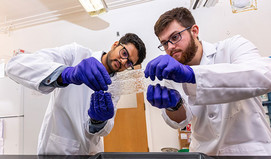
Cellulose from Ag Residue to Make Clear Biodegradable Film
Making a transparent, biodegradable film from crop residue and native grasses — that is the goal that South Dakota State University (SDSU) Assistant Professor Srinivas Janaswamy is pursuing through a three-year, $481,618 USDA grant. “We are extracting cellulose fraction from renewable agricultural residues and then solubilizing it to make strong, biodegradable films,” Janaswamy said. Using the nation’s abundant supply of agricultural biomass to create biodegradable products that can replace petroleum-based plastics will reduce the environmental impact of these packaging and generate extra income for farmers. Janaswamy is developing processes to extract cellulose fraction from corn stover and soybean biomass, wheat, and oat straw, as well as switchgrass and prairie cordgrass through the USDA-National Institute of Food and Agriculture project. For more information, read this News@SDState article.
Master’s student Sajal Bhattarai, left, and undergraduate Jake Larsen examine the smooth, clear film they made from the cellulose gel. Image courtesy of SDSU.
|
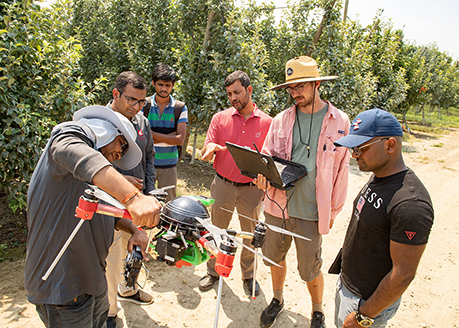
National AI Research Institute for Ag to be Led by Washington State University
With a new $20 million federal grant, Washington State University (WSU) will lead a multi-institutional research institute to develop artificial intelligence (AI) solutions to tackle some of agriculture’s biggest challenges related to labor, water, weather and climate change. The new institute is one of 11 launched by the National Science Foundation and among two funded by USDA’s National Institute of Food and Agriculture in 2021. It’s called the AgAID Institute, which is short for USDA-NIFA Institute for Agricultural AI for Transforming Workforce and Decision Support. The AgAID Institute will be a multi-disciplinary, collaborative effort involving faculty and scientists with expertise on a diverse range of areas in computer science, agriculture, and agricultural outreach. For more information, read this WSU Insider article.
WSU post-doctoral fellow Abhilash Chandel explains to an AgAID Institute team how the drone’s sensing technology collects multispectral and thermal imagery data. Image courtesy of WSU.
|
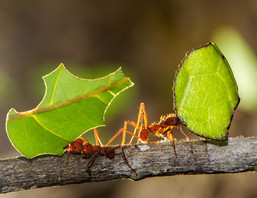
Fungus that Tastes Just Right
Leaf-cutter ants know what food they like to eat. They turn up their scent-detecting antennae at some plant material in soils in favor of others that fungus has degraded, just the way they like it. That’s partly because the ants helped cultivate the fungi and they know where the fungus holds its nutrients. In an ongoing study, Pacific Northwest National Laboratory (PNNL) researchers are forming a clearer picture of how plant matter is transformed in the microbial gardens the ants create. Researchers focused on lipids present in the leaf-cutter ants’ cultivated fungus. A detailed understanding of how fungus degrades biomass could one day help scientists develop microbial systems for sustainable bioproduct production, such as biofuels or renewable chemicals. The research received support by USDA’s National Institute of Food and Agriculture. For more information, read this PNNL article.
Leafcutter ants carrying a leaf to their nest, courtesy of Getty Images.
|
NIFA Invests $2.5 Million to Support Farmers, Ranchers, and Veterinarians Avoidance of Residue
NIFA recently awarded five grants in the Food Animal Residue Avoidance Databank (FARAD) program. NIFA supports FARAD, a repository of comprehensive residue avoidance system designed to provide livestock producers, extension specialists, and veterinarians with practical information on how to avoid drug, pesticide, and environmental contaminant residue problems real-time (24/7/365). Farmers and ranchers recognize food residue avoidance as an important step to improving agriculture and animal health, a key to consumer confidence.
USDA SBIR Program Awards $873,791 in Small and Mid-Size Farms Grants to Small Businesses
The USDA Small Business Innovation Research (SBIR) Program, administered by NIFA, recently awarded nine grants to U.S. small business to promote and improve the sustainability and profitability of small and mid-size farms and ranches.

|
|
|
NIFA’s mission is to invest in and advance agricultural research, education, and extension that solve societal challenges. NIFA’s investments in transformative science directly support the long-term prosperity and global preeminence of U.S. agriculture. Keep informed about NIFA, USDA, our land-grant and non-land-grant university partners, and stakeholders with the NIFA Update. Read past issues online, sign up for email updates or follow us on Twitter @USDA_NIFA, #NIFAImpacts or LinkedIn @usda-nifa.
If you wish to submit a news item or information, send an email to NIFAUpdate.
USDA is an equal opportunity lender, provider, and employer.
|
|
|
|